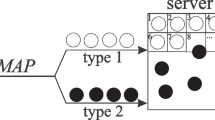Abstract
Mathematical strategy portrays the performance evaluation of computer and communication system and it deals with the stochastic properties of the multiclass Markovian queueing system with class-dependent and server-dependent service times. An algorithm is designed where the job transitions are characterized by more than one closed Markov chain. Generating functions are implemented to derive closed form of solutions and product form solution with the parameters such as stability, normalizations constant and marginal distributions. For such a system with N servers and L chains, the solutions are considerably more complicated than those for the systems with one sub-chain only. In Multi-class queueing network, a job moves from a queue to another queue with some probability after getting a service. A multiple class of customer could be open or closed where each class has its own set of queueing parameters. These parameters are obtained by analyzing each station in isolation under the assumption that the arrival process of each class is a state-dependent Markovian process along with different service time distributions. An algorithmic approach is implemented from the generating function representation for the general class of Networks. Based on the algorithmic approach it is proved that how open and closed sub-chain interact with each other in such system. Specifically, computation techniques are provided for the calculation of the Markovian model for multiple chains and it is shown that these algorithms converge exponentially fast.
Similar content being viewed by others
References
Bylina, J.: Distributed solving of Markov chains for computer network models. Annales UMCS Informatica. Lublin. 1, 15–20 (2003)
Chen, B.Y., Lam, W.H.K., Sumalee, A., Li, Q., Tam, M.L.: Reliable shortest path problems in stochastic time-dependent networks. J. Intell. Transp. Syst. Technol. Plan. Oper. 18(2), 177–189 (2014)
Bhattacharjee, A., Nandi, S.: Statistical analysis of network traffic inter-arrival. In: Proceedings of the 12th International Conference on Advanced Communication Technology, ICACT’10, IEEE Press, pp. 1052–1057 (2010)
Ching, W.-K., Huang, X., Ng, M.K., Siu, T.K.: Markov chains : Models, algorithms and applications. International Series in Operations Research and Management Science, vol. 189, 2nd ed. ISBN: 978-1-4614-6311-5, 978-1-4614-6312-2 (2013)
Morozov, E.: Stability criterion of a general multiserver multiclass queueing system. In: 29th International Symposium on Computer and Information Sciences (ISCIS), pp. 229–238 (2014)
Graham, C.: Robert: interacting multi-class transmissions in large stochastic networks. Ann. Appl. Prob. 19, 2334–2361 (2009)
Domańska, J., Domańska, A., Czachórski, T.: A few investigations of long-range dependence in network traffic. In: Czachorski, T., Gelenbe, E., Lent, R. (eds.) Information Science and Systems, pp. 137–144. Springer International Publishing, Switzerland (2014)
MacGregor Smith, J.: System capacity and performance modelling of finite buffer queueing networks. Int. J. Prod. Res. 52(11), 3125–3163 (2014)
van Woense Frederico, T., Cruz, R.B.: Optimal routing in general finite multi-server queueing networks. doi:10.1371/journal.pone.0102075 (2014)
Tadj, L., Choudhury, G.: Optimal design and control of queues. Top 13, 359–412 (2005)
Tijms HC. A first course in stochastic models. Weily, Chichester (2003). ISBN:0471498807
Valakevicius, E., Pranevicius, H.: An algorithm for creating Markovian models of complex systems. In: Proceedings of the 12th World Multi-Conference on Systemics, Cybernetics and Informatics, Orlando, USA, pp. 258–262 (2008)
Dai, J., Hasenbein, J., Kim, B.: Stability of join-the-shortest-queue networks. Queueing Syst. 57, 129–145 (2007)
Harchol-Balter, M., Osogami, T., Scheller-Wolf, A., Wierman, A.: Multi-server queueing systems with multiple priority classes. Queueing Syst. Theory Appl. 51, 331–360 (2005)
Khalid, R., Nawawi, M.K.M., Kawsar, L.A., Ghani, N.A., Kamil, A.A., et al.: A discrete event simulation model for evaluating the performances of an M/G/C/C state dependent queuing system. PLoS One 8, e58402 (2013). doi:10.1371/journal.pone.0058402
Manitz, M.: Analysis of assembly/disassembly queueing networks with blocking after service and general service times. Ann. Oper. Res. 226(1), 417–441 (2014)
Morozov, E., Fiems, D., Bruneel, H.: Stability analysis of multiserver discrete-time queueing systems with renewal-type server interruptions. Perform. Eval. 68, 1261–1275 (2011)
Nogueira, A., Salvador, P., Valadas, R., Pacheco, A.: Markovian Modelling of Internet Traffic. In: Network Performance Engineering, pp. 98–124. Springer, Berlin (2011)
Author information
Authors and Affiliations
Corresponding author
Rights and permissions
About this article
Cite this article
Sivaselvan, K., Vijayalakshmi, C. Implementation of Markovian Queueing Network Model with Multiple Closed Chains. Math.Comput.Sci. 10, 263–272 (2016). https://doi.org/10.1007/s11786-016-0262-4
Received:
Revised:
Accepted:
Published:
Issue Date:
DOI: https://doi.org/10.1007/s11786-016-0262-4




